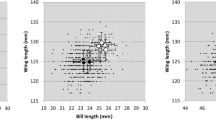Abstract
The flight muscles of different honeybee subspecies are known to have different allozymes of malate dehydrogenase (Mdh) which in turn are correlated with differences in mass-specific metabolic flight rate. Flight capacity is also affected by dimensional, morphological relationships of mass and area which allow an estimation of an “excess power index”. The dimensions of the flight machinery of honeybees (based on our own data) were coupled with the frequency distributions of Mdh (taken from the literature) to compare nine subspecies of African and nine European honeybees, Apis mellifera as miniature aircraft. The two groups differed significantly for five dimensions of flight machinery and in the distribution frequencies of Mdh phenotypes. In the African group, northern and southern subgroups occurred which significantly differed in body mass and excess power index, while flight engine and body mass varied proportionately. In the European group, wing surface was nearly constant but body mass and the thorax/body mass ratio varied significantly resulting in significantly differing wing loading values. The final excess power index (modified for allozyme phenotype) of the European bees reflected both flight machinery and allozymic differences. Mdh allozymic phenotype frequencies were correlated with the dimensional morphological components of the excess power index. As a group, the European subspecies of honeybees were 33% heavier and had 15% more wing surface area than the African group. However, the former have a thorax/body mass ratio of 0.45 and wing loading value of 0.48 against the latter's 0.53 and 0.35 respectively. This confers an advantage on the African group solely on the grounds of dimensions because there was proportionately less mass per unit area of wing surface and so lower lift requirement. The better engine to aircraft mass ratio provides greater power per unit mass in the African group taken as miniature aircraft. Differences in metabolic capacity associated with Mdh allozymes (taken from the literature) finally result in an excess power index that is 38% greater in the African than European subspecies of honeybees.
Similar content being viewed by others
Author information
Authors and Affiliations
Additional information
Accepted: 22 December 1998
Rights and permissions
About this article
Cite this article
Hepburn, H., Radloff, S. & Fuchs, S. Flight machinery dimensions of honeybees, Apis mellifera. J Comp Physiol B 169, 107–112 (1999). https://doi.org/10.1007/s003600050200
Issue Date:
DOI: https://doi.org/10.1007/s003600050200




